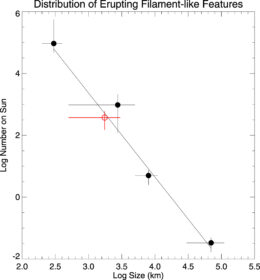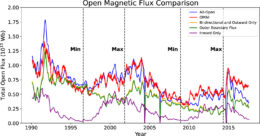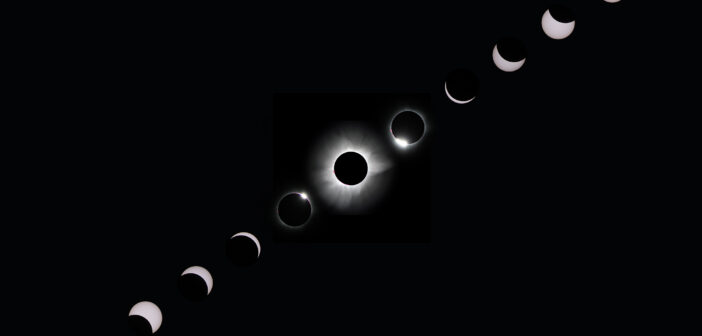Today’s the day! The Moon’s shadow will sweep across Mexico, the United States, and eastern Canada, plunging millions of eclipse viewers into a few minutes of mid-afternoon twilight. I’ll be enjoying a partial eclipse in partly cloudy Colorado, having bailed on my original plans for totality in Texas due to thunderstorms. See you all in Spain in August 2026, perhaps?
Whether your plans have been sidelined by weather or you’re enjoying the eclipse under sunny skies, take a moment to delve into three solar physics research articles with us today to learn how researchers are studying our home star.
Launching the Solar Wind with Tiny Jets
The solar wind is a hot, tenuous plasma that constantly streams out from the Sun, whipping past Earth at about 400 kilometers per second. How the solar wind is launched from the Sun’s atmosphere is a hot topic, with recent research suggesting that thousands of small jets powered by the release of pent-up magnetic energy could provide the boost the solar wind needs to get going.

Number and size distribution of erupting filaments on the Sun. From left to right, the black circles represent microfilament eruptions, jetlets, minifilament eruptions, and solar flares and coronal mass ejections. [Sterling et al. 2024]
Looking more closely at the connection between jets and the solar wind, Sterling’s team proposed that when a flux rope erupts, the material ensnared within the rope is launched outward, and the intrinsic twist of the magnetic field in a flux rope could be transferred to field lines that extend out into the solar system. The movement of this magnetic field twist could produce magnetic zigzags called switchbacks, which have been observed in detail by the Parker Solar Probe and Solar Orbiter, connecting the beginnings of the solar wind to phenomena seen farther downwind.
A Coronal Mass Ejection Seen from Mercury, Earth, and Other Locations in Space
With spacecraft orbiting Earth, zooming around other planets, and even skimming the Sun’s atmosphere, we can study the Sun from more angles than ever before. In February 2022, three spacecraft made ultraviolet observations of a loop of solar plasma suspended within the Sun’s magnetic field. The loop of plasma, called a prominence, eventually erupted as a coronal mass ejection. The BepiColombo spacecraft and the Parker Solar Probe weathered the coronal mass ejection from their positions near Mercury’s orbit, just 0.35 au from the Sun.

Three extreme-ultraviolet viewpoints of the same event on 15 February 2022. From left to right: the STEREO spacecraft, at Earth’s orbital distance; Solar Orbiter, around 0.75 au; and the GOES spacecraft, in orbit around Earth. [Palmerio et al. 2024]
This allowed Erika Palmerio (Predictive Science Inc.) and collaborators to study how the structure of a coronal mass ejection varies on these scales. Despite the small separation of the spacecraft, many of the properties they measured were considerably different. For example, they measured different directions of the shock as it passed over them, and the time it took for the coronal mass ejection to pass over them was measured to be different by more than 9 hours. This reveals that coronal mass ejections have considerable variations over the scales examined in this study, and more work is needed to understand how and why these variations exist.
A Potential Solution to a Persistent Problem
Magnetic field lines that emerge from the Sun’s surface and loop back to re-enter the surface are called closed field lines, while those that extend out into the solar system are called open field lines. For decades, researchers modeling the solar corona have encountered a persistent issue: models predict far less open magnetic flux than spacecraft measure. The discrepancy can be a factor of two or more, and the mismatch tends to be greatest when modeling the Sun at its most active.

Comparison of the observed open magnetic flux (red line) with the results of various methods of tallying the flux. The blue line shows the results of the method explored in this study. Click to enlarge. [Arge et al. 2024]
The mismatch between the two methods is greatest when the grid cells of the model fall upon an active region — an area of especially strong and complicated magnetic fields — that lies on the edge of a coronal hole, where a concentration of open magnetic field lines carries solar plasma into space. This fact hints at why previous methods were least successful in matching the observed open flux when the Sun was active; high solar activity means more active regions, and more opportunities to miss open flux.
While the new method hasn’t yet been perfected, tending to overestimate the open magnetic flux in some cases, the authors hope that it will finally bring the open flux mystery to a close.
Citation
“How Small-Scale Jetlike Solar Events from Miniature Flux Rope Eruptions Might Produce the Solar Wind,” Alphonse C. Sterling et al 2024 ApJ 963 4. doi:10.3847/1538-4357/ad1d5f
“On the Mesoscale Structure of Coronal Mass Ejections at Mercury’s Orbit: BepiColombo and Parker Solar Probe Observations,” Erika Palmerio et al 2024 ApJ 963 108. doi:10.3847/1538-4357/ad1ab4
“Proposed Resolution to the Solar Open Magnetic Flux Problem,” C. Nick Arge et al 2024 ApJ 964 115. doi:10.3847/1538-4357/ad20e2

